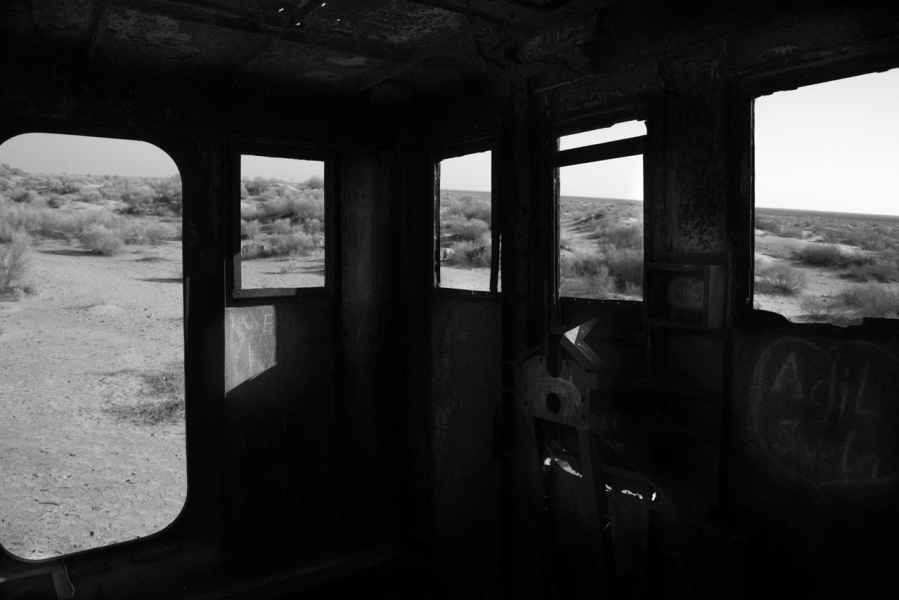Uzbekistan - Mar di Aral
Il peggior disastro ambientale causato dall'uomo.
Dai primi decenni del ‘900, l’allora URSS, utilizzava i territori dell’Asia Centrale per lo sfruttamento industriale e militare a favore di Mosca. In queste lande desolate vennero impiantati siti nucleari ed eseguiti per decenni test con armi chimiche e batteriologiche.
Prima della dissoluzione dell’URSS, le scorie chimiche e batteriologiche militari vennero stoccate come rifiuti tossici in questa zona e sull’isola di Vozrozdenie, in italiano “rinascita”, luogo che aveva ospitato laboratori nei quali si sperimentavano armi chimiche, virus e batteri sugli animali; oggi che l’isola non è più completamente circondata dalle acque il timore è che questi animali possano migrare nei territori circostanti e propagare malattie sconosciute con la loro carica infettiva. Una storia che ultimamente è tornata alla ribalta con il caso “Novichok”.
Negli anni ‘60 i terreni brulli e aridi divennero campi di grano e di cotone, a quel tempo i Sovietici vollero sfidare gli statunitensi per diventare il maggiore produttore al mondo di cotone, un ‘miracolo’ da realizzazione con un reticolo di canali che deviavano le acque dei fiumi circostanti, soprattutto i più grandi immissari del lago d’Aral, Amu Darya e Syr Darya. Grande fino alla metà del secolo scorso quanto un mare, chiamato infatti anche Mare d’Aral per le sue acque salate. Così il lago ha ricevuto sempre meno acqua e anche a causa della maggiore evaporazione, in soli quarant’anni ha visto arretrare la linea della costa in alcuni punti anche di 150 km. Oggi questo bacino sta scomparendo diviso in Piccolo Aral e Grande Aral, separati da una grande distesa di 40.000 kmq di sabbia e sale. Cimitero di navi arrugginite, vecchie gru e serbatoi con metalli velenosi quando non radioattivi, provenienti dalla base militare sovietica che sorgeva sull’ isola di cui si è accennato.
Oggi il territorio, ricco di gas naturali, è sfruttato dalle multinazionali dell’Energia, difficilmente tornerà il Mare di prima, il solo Kazakistan, più a nord, ha arginato il prosciugamento con una serie di dighe ma solo una parte è nel suo territorio.
The worst man-made environmental disaster.
From the early decades of the 1900s, the then USSR used the territories of Central Asia for industrial and military exploitation in favor of Moscow. Nuclear sites were set up in these wastelands and tests with chemical and bacteriological weapons were carried out for decades. Before the dissolution of the USSR, the chemical and bacteriological military waste was stored as toxic waste in this area and on the island of Vozrozdenie, in Italian "rebirth", a place that had hosted laboratories in which chemical weapons, viruses and bacteria were tested on animals; now that the island is no longer completely surrounded by waters, the fear is that these animals could migrate to the surrounding territories and spread unknown diseases with their infectious load. A story that has recently made a comeback with the “Novichok” case. In the 1960s the barren and arid lands became fields of wheat and cotton, at that time the Soviets wanted to challenge the Americans to become the world's largest producer of cotton, a 'miracle' to be accomplished with a network of channels that diverted the waters of the surrounding rivers, especially the largest tributaries of the Aral Sea, Amu Darya and Syr Darya. As large until the middle of the last century as a sea, in fact also called the Aral Sea for its salty waters. Thus the lake has received less and less water and also due to greater evaporation, in just forty years it has seen the coastline retreat in some places by up to 150 km. Today this basin is disappearing divided into the Little Aral and the Great Aral, separated by a large expanse of 40,000 sq km of sand and salt. Graveyard of rusty ships, old cranes and tanks with poisonous metals when not radioactive, coming from the Soviet military base that stood on the mentioned island. Today the territory, rich in natural gas, is exploited by the Energy multinationals, it is unlikely that the sea will return to the past, only Kazakhstan, further north, has stemmed the drainage with a series of dams but only a part is in its territory.
Error



















